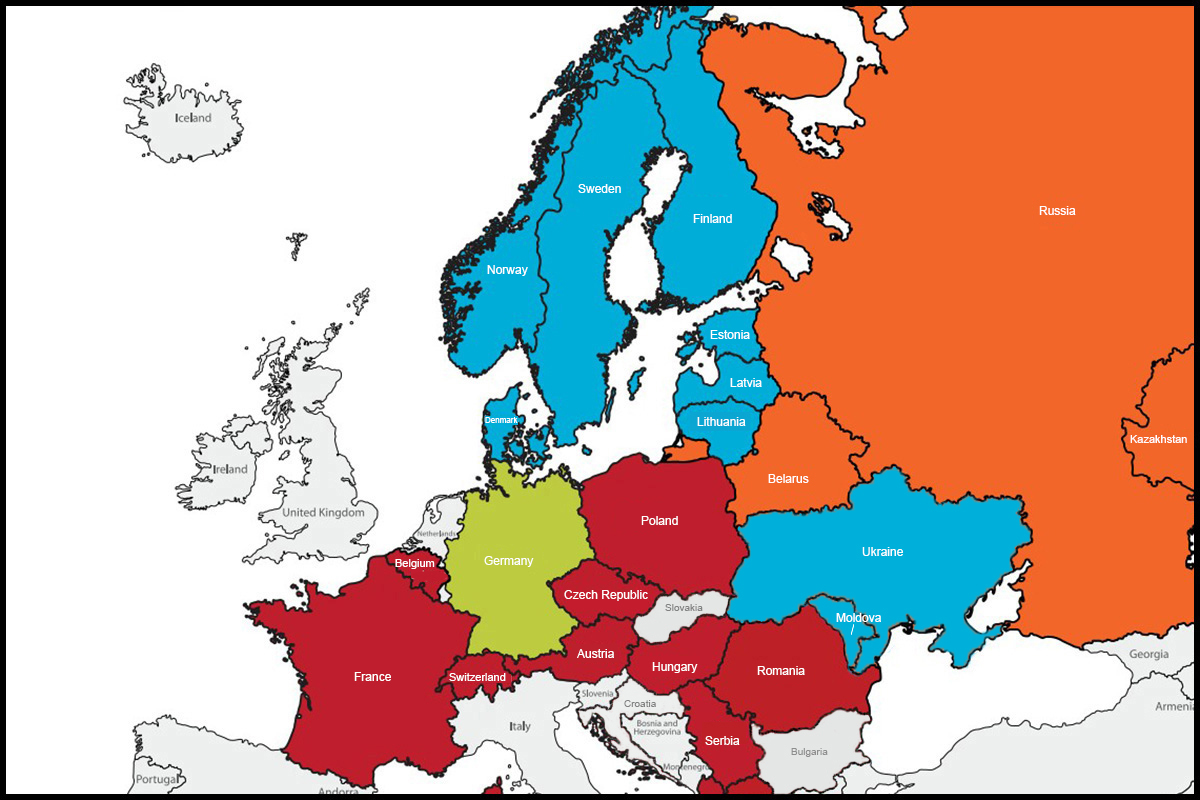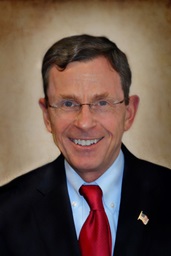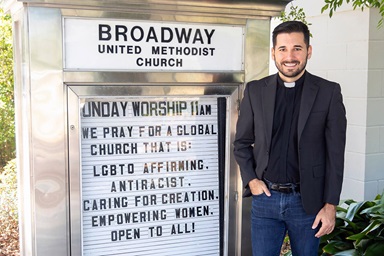Key points:
- Church regions in Eurasia and the Baltics, built up after the breakup of the Soviet Union, now plan to leave The United Methodist Church.
- Church law has a multistep process for church regions outside the United States to change their relationship with the denomination.
- Delegates of the Northern Europe and Eurasia Central Conference voted on March 18 to allow the church regions to begin the withdrawal process.
Amid an ongoing church separation, United Methodists across Russia, Belarus, Kyrgyzstan, Kazakhstan and Estonia have taken the initial steps toward leaving the denomination en masse.
At a special online session March 18, delegates of the Northern Europe and Eurasia Central Conference — by a 40-20 vote with two abstentions — supported those departures moving forward.
Specifically, the delegates voted for the church regional bodies of the Central Russia, the Northwest Russia and Belarus Provisional, the Eastern Russia and Central Asia Provisional, and the South Russia Provisional annual conferences to become autonomous using a yearslong process in the church’s law book.
In the same vote, the delegates also approved a process for churches within Estonia to disaffiliate from the denomination while also providing care for churches in that Baltic nation that opt to remain United Methodist.
However, a majority of delegates voted against allowing annual conferences within the central conference that plan to stay United Methodist to set their own standards for ordination and for entering into marriage.
The United Methodist Church built up its presence in Estonia, Russia and its neighboring countries in the new openness that followed the breakup of the Soviet Union and the end of the Cold War. During the Soviet period, the church in Estonia had seen its pastors killed or exiled to Siberia.
In many ways, the March 18 votes are emblematic of growing strains in the wider world and the wider denomination.
“This has been a demanding conference in many ways,” Nordic and Baltic Area Bishop Christian Alsted said at the end of the online meeting.
Alsted, who presided at the gathering, thanked the delegates for their respectful tone during some very tense conversations. Originally scheduled for three hours, the online session ran almost an hour longer before the final vote took place.
“It is not necessarily a decision that is received with the same joy or appreciation by all members of the conference,” Alsted said. “Nevertheless, this is the decision that we were able to make together.”
European and Eurasian conferences are large geographically, but typically small in membership.
The four Eurasian annual conferences — all led by Bishop Eduard Khegay — have 66 United Methodist churches in total. Altogether the conferences had 1,123 members as of 2017, according to the most recent data from the denomination’s General Council on Finance and Administration.
The Estonia District, which encompasses the entire country, is part of the larger Estonia Annual Conference that covers the Baltics and is under Alsted's leadership. The district, the part of the conference planning disaffiliation, currently has 25 United Methodist churches with a total of about 1,650 members.
The withdrawal vote comes as The United Methodist Church is undergoing a slow-motion separation after decades of intensifying debates over the role of LGBTQ people in the church.
The Book of Discipline, the denomination’s law book, bans the officiation of same-sex weddings and the ordination of “self-avowed practicing” gay clergy.
However, those bans have faced increasing defiance in some parts of the denomination, and many United Methodists in the U.S. and western Europe have been working to eliminate those restrictions.
Meanwhile, many United Methodists in eastern Europe identify as traditionalist and want the bans to remain unchanged and strictly enforced.
Last year, representatives of The United Methodist Church in Bulgaria (which is in a different central conference) voted to leave The United Methodist Church and immediately join the Global Methodist Church, a new, traditionalist breakaway denomination that had recently launched. Members of the Judicial Council, the denomination’s top court, later said in a memorandum that the group had violated church law in its hasty exit.
Eurasia Bishop Khegay, a traditionalist who has long planned to depart The United Methodist Church, has made clear that he and the four conferences he leads want to follow established processes in the departure.
Unlike in the United States, the Discipline has a mechanism in Paragraph 572 for annual conferences within central conferences — church regions in Europe, Africa and the Philippines — to change their relationship with the denomination. The paragraph was last used about a decade ago when Swedish United Methodists asked to leave The United Methodist Church to join with the Uniting Church in Sweden.
However, a conference’s exit takes time and requires the approval of General Conference, the denomination’s top lawmaking assembly now scheduled for April 23-May 3, 2024. The departure of the Eurasian conferences won’t be finalized until 2025. That means delegates from those conferences will be among those voting at the coming General Conference.
Meanwhile, the process approved for the Estonia District could take place on a quicker timeline. The process requires a vote in each Estonian congregation. The district said it plans to confirm the final separation in June this year if at least two-thirds of the congregations have voted for withdrawal. The petition for the district's withdrawal also changes the name of the Estonia Annual Conference to Baltic Annual Conference, since the conference also includes United Methodist churches in the countries of Lithuania, Latvia as well as any churches that remain or the conference plants in Estonia.
In approving the exit process for the Estonia District, the central conference took advantage of authority under the denomination’s constitution to make “such changes and adaptations” to the Discipline as missional needs and differing legal contexts require.
The central conference session featured no debate about the process of the planned withdrawals. However, the denomination’s ongoing dispute over LGBTQ inclusion hovered over the discussion. In some ways, the conversation may foreshadow the wrangling to come at General Conference, which has long been the denomination’s main battleground over LGBTQ policies.
A particular sticking point was a section in the petition for Estonia’s withdrawal that would allow annual conferences within the central conference to set their own policies related to marriage and ordination so long as those policies aligned with the denomination’s doctrine and general rules.
The Rev. Priit Tamm, a delegate from Estonia, objected to including that section in the motion allowing Estonia to leave.
“This is pushing those who wish to leave into supporting something they in fact disagree with,” he said. “This pushes us into hypocrisy. To be consistent with our conscience, we would have to vote against the whole thing.”
The Rev. Hilde Marie Movafagh, a delegate from Norway, argued for keeping the petition whole because it would represent the different parties giving each other what they need for the future.
“I myself would not like to see Estonia leave, and I would not like Eurasia to leave either,” she said. “I would like us all to be in the same church. But by giving you the future you need, I give something to you and then I would like you to give back the tools we need for our church.”
Ultimately, a majority of the delegates opted to remove that section, and the joint motion for withdrawal later passed.
In a statement released March 20, the Rev. Knut Refsdal, a district superintendent in Norway, expressed his annual conference’s disappointment in the central conference’s outcome.
He said the motion was developed jointly by the Nordic, Baltic and Ukrainian members of the central conference’s council to take care of everyone’s needs. He added that it would now be up to the Norway Annual Conference, when it meets in June, to determine its next steps.
The central conference previously has seen relations strained by international conflict.
The Northern Europe and Eurasia Central Conference held a very different special session last year following Russia’s invasion of Ukraine. That special session voted to temporarily move the Ukrainian-Moldova Provisional Annual Conference (at that conference’s request) from the area supervised by Moscow-based Khegay to Alsted’s Copenhagen, Denmark-based area.
Khegay, at personal risk, openly criticized Russia’s invasion of Ukraine. But he also spoke out against moving the Ukraine-Moldova Conference from his area, suggesting it was a territorial grab. Delegates from Russia, Belarus, Kyrgyzstan and Kazakhstan ended up boycotting last year’s vote.
However, for this year’s special session, almost all of the central conference’s 64 voting delegates participated. Ukrainian United Methodists, who have received support from across the denomination, so far show no indications of wanting to withdraw from The United Methodist Church.
Hahn is assistant news editor for UM News. Contact her at (615) 742-5470 or [email protected]. To read more United Methodist news, subscribe to the free Daily or Friday Digests.




